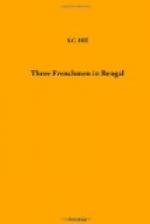At Lucknow Suja-ud-daula greeted him with a sympathetic interest, which Law quaintly likens to that shown by Dido for Aeneas, but money was not forthcoming, and Law soon found that Suja-ud-daula was not on sufficiently good terms with the Mogul’s[110] Vizir[111] at Delhi to risk an attack on Bengal. On the 18th of October he returned to Allahabad, with the intention of going to Delhi to see what he could do with the Vizir, but as it might have been dangerous to disclose his object, he pretended he was going to march south to Bussy in the Deccan, and obtained a passport from the Maratha general, Holkar. This took some time, and it was not till March, 1758, that he started for Delhi. He reached Farukhabad without difficulty, and on the 21st entered the country of the Jats. On the evening of the 23rd a barber, who came into their camp, warned the French they would be attacked. The next day the Jats, to the number of 20,000, attacked them on the march. The fight lasted the whole day, and the French fired 6000 musket shots and 800 cannon. The cannon-balls were made of clay moulded round a pebble, and were found sufficiently effective in the level country.
Soon after they arrived at Delhi, only to find the Marathas masters of the situation and in actual possession of the person of the Shahzada, or Crown Prince.[112] The Prince was friendly, gave Law money, and eagerly welcomed the idea of attacking Bengal, but he was himself practically a prisoner. The Vizir, too, could do nothing, and would give no money. The Marathas amused him with promises, and tried to trap him into fighting their battles. No one seemed to know anything about what had happened in Bengal. He spoke to several of the chief men about the English.
“I felt sure that, after the Revolution in Bengal, they would be the only subject of conversation in the capital. The Revolution had made much noise, but it was ascribed entirely to the Seths and to Rai Durlabh Ram. Clive’s name was well known. He was, they said, a great captain whom the Seths had brought from very far at a great expense, to deliver Bengal from the tyranny of Siraj-ud-daula, as Salabat Jang had engaged M. Bussy to keep the Marathas in order. Many of the principal persons




